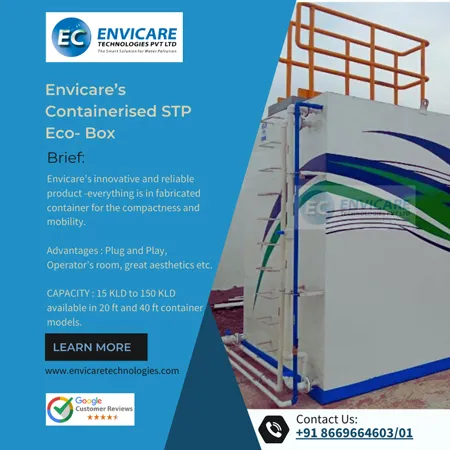
Capacity: 25 -150 KLD Technology: MBBR / SAFF /MBR
We are Manufacturer, Supplier, Exporter of Sewage Treatment Plants (STP) from Pune, Maharashtra, India.
A containerized Sewage Treatment Plant (STP) is a modular and portable system for treating wastewater, typically housed in standard shipping containers. These units are designed to be easily transported and quickly set up, providing an efficient solution for sewage treatment in various settings. Here’s an overview of its applications and benefits:
- Temporary Settlements: Construction sites, mining camps, and military bases where a permanent sewage treatment infrastructure is not viable.
- Remote Communities: Small villages and rural areas lacking centralized sewage systems.
- Disaster Response: Quick deployment to areas affected by natural disasters to provide immediate wastewater treatment.
- Humanitarian Missions: Aid organizations can use these units to establish sanitation in refugee camps and disaster-stricken regions
- Industries: Factories, refineries, and other industrial sites where wastewater treatment is necessary but a full - scale treatment plant is not practical.
- Commercial Establishments: Hotels, resorts, and large events like festivals or sports events where temporary or additional wastewater treatment capacity is needed.
- Supplementary Treatment: Cities can use containerized STPs to supplement existing sewage treatment capacity during peak times or maintenance periods.
- Decentralized Treatment: New urban developments or peri-urban areas not yet connected to the central sewage system.
- Easy Transportation: Designed to fit into standard shipping containers, making them easy to transport by road, rail, or sea.
- Quick Setup: Can be quickly deployed and operational, reducing downtime and ensuring rapid wastewater treatment.
- Modular Design: Units can be added or removed based on the required treatment capacity, allowing for scalable solutions.
- Lower Initial Investment: Reduced need for extensive civil works and infrastructure compared to traditional plants.
- Reduced Operational Costs: Lower maintenance and operational costs, especially for smaller installations.
- State-of-the-Art Processes: Often equipped with advanced treatment technologies like Membrane Bioreactors (MBR), Sequencing Batch Reactors (SBR), or Moving Bed Biofilm Reactors (MBBR).
- High Efficiency: Capable of achieving high levels of treatment efficiency, meeting stringent discharge standards.
- Minimal Footprint: Compact design requires less space, preserving land for other uses.
- Sustainable: Helps in managing wastewater in an eco-friendly manner, reducing pollution and protecting water bodies.
- Variety of Applications: Suitable for both temporary and permanent installations, across various industries and settings.
- Customizable: Can be tailored to specific needs, including varying capacities and treatment levels.
- Semi - automatic Operation.
- Required less space as compared to conventional design.
- Very Compact and Great aesthetic.
- Reduced Installation and commissioning time on site.
- Plug and play operation.
- Easy Dismantling and transportation.
- Standard and made-to-order product.
- Civil Work - Collection Tank and Container Foundation.
- IT Complex, Hotels & Restaurants, Labour Camps, etc.
Containerized Sewage Treatment Plants provide a versatile, efficient, and cost-effective solution for wastewater treatment in diverse settings. Their portability, quick setup, and advanced treatment capabilities make them ideal for remote areas, emergency situations, industrial applications, and supplementary municipal needs. By offering scalable and environmentally friendly wastewater management, these systems are a valuable tool in ensuring proper sanitation and protecting water resources.


